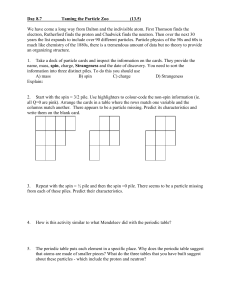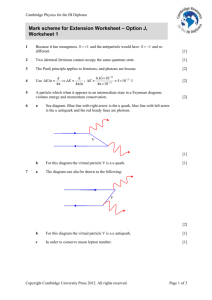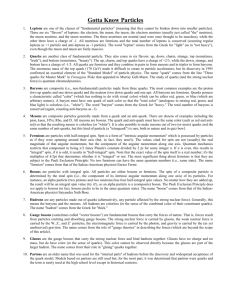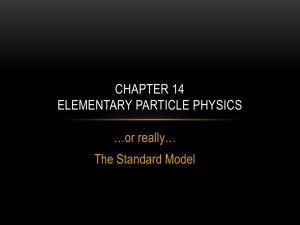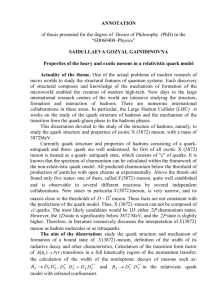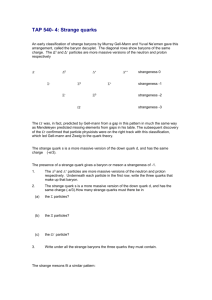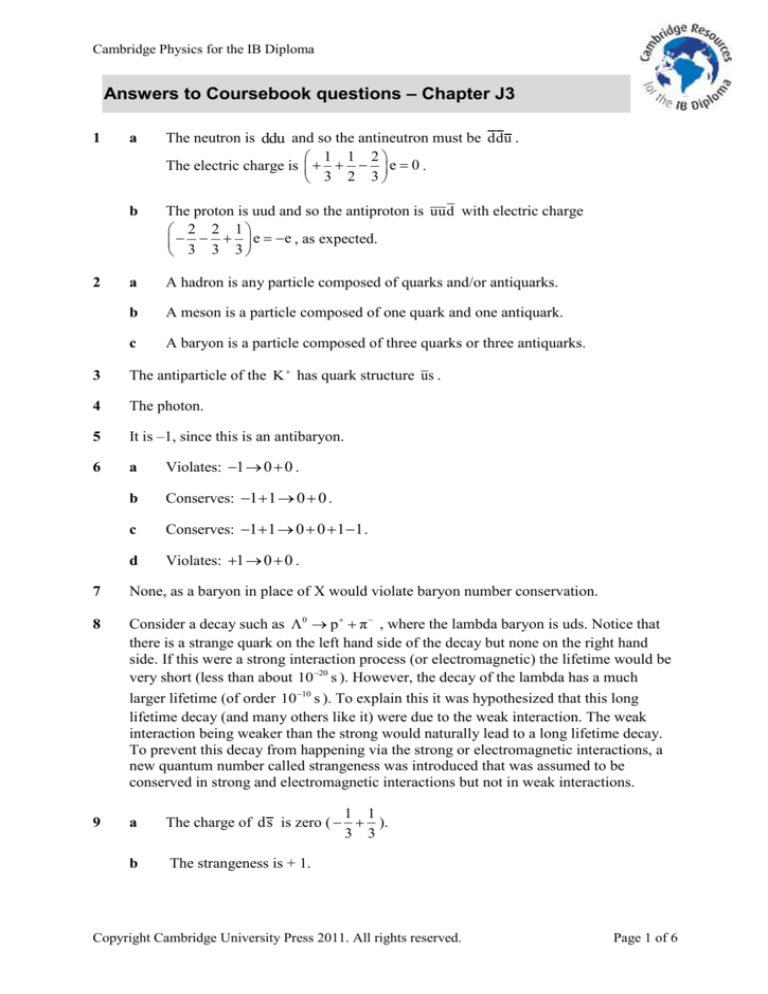
Cambridge Physics for the IB Diploma
Answers to Coursebook questions – Chapter J3
1
2
a
The neutron is ddu and so the antineutron must be ddu .
1 1 2
The electric charge is e 0 .
3 2 3
b
The proton is uud and so the antiproton is uud with electric charge
2 2 1
e e , as expected.
3 3 3
a
A hadron is any particle composed of quarks and/or antiquarks.
b
A meson is a particle composed of one quark and one antiquark.
c
A baryon is a particle composed of three quarks or three antiquarks.
3
The antiparticle of the K has quark structure us .
4
The photon.
5
It is –1, since this is an antibaryon.
6
a
Violates: 1 0 0 .
b
Conserves: 1 1 0 0 .
c
Conserves: 1 1 0 0 1 1 .
d
Violates: 1 0 0 .
7
None, as a baryon in place of X would violate baryon number conservation.
8
Consider a decay such as 0 p π , where the lambda baryon is uds. Notice that
there is a strange quark on the left hand side of the decay but none on the right hand
side. If this were a strong interaction process (or electromagnetic) the lifetime would be
very short (less than about 10 20 s ). However, the decay of the lambda has a much
larger lifetime (of order 10 10 s ). To explain this it was hypothesized that this long
lifetime decay (and many others like it) were due to the weak interaction. The weak
interaction being weaker than the strong would naturally lead to a long lifetime decay.
To prevent this decay from happening via the strong or electromagnetic interactions, a
new quantum number called strangeness was introduced that was assumed to be
conserved in strong and electromagnetic interactions but not in weak interactions.
9
a
1 1
The charge of ds is zero ( ).
3 3
b
The strangeness is + 1.
Copyright Cambridge University Press 2011. All rights reserved.
Page 1 of 6
Cambridge Physics for the IB Diploma
10
11
a
2 1
The charge of cd is e ( 1 ).
3 3
b
The strangeness is zero since it does not have strange quarks in it.
To answer this question you must look up the quark content of the various particles in
the textbook.
a
Conserves: 0 0 1 1
b
Conserves: 0 0 1 1
c
Violates: 1 0 0
d
Violates: 0 0 0 1
12
No. With just one strange quark the strangeness would be – 1. The antiparticle would
then have strangeness + 1 and so could not be the same as the particle.
13
Since c c c the antiparticle of the c is c c , i.e. is the same as the c itself.
However, the antiparticle of the meson K 0 ds would be sd and is different.
14
15
a
2 1 1
Q 0 , S 0 0 1 1 .
3 3 3
b
No. If they did the baryon itself would have colour, and this is not possible due to
confinement.
a
The spin of a quark is s
2
6.63 1034
5.28 1035 J s .
4π
Copyright Cambridge University Press 2011. All rights reserved.
Page 2 of 6
Cambridge Physics for the IB Diploma
b
The spins of the three quarks making up a baryon can be all up or two can
be up and one down. In the first case the spin of the baryon is 3/2 and in
the second it is 1/2. For mesons, both spins can be up, leading to spin 1, or
one up and one down, leading to spin zero.
spin 3/2
baryons
spin 1/2
spin 1
mesons
spin 0
16
17
18
a
The electron and the positron each have spin ½. If both spins are up, positronium
has spin 1 (this state is called orthopositronium). If one spin is up and the other is
down the total spin is zero (called parapositronium).
b
Parapositronium can decay into two photons whose spins are up and down,
making a spin of zero. Orthopositronium can decay into three photons, where two
photons have spin up and one has spin down, making a total spin of 1. It cannot,
however, decay into a single photon because this would violate conservation of
ordinary momentum – in a frame of reference in which the electron and positron
have zero total momentum. Momentum must be conserved and so the end state
must also have zero momentum. This cannot be achieved with a singe photon that
has non- zero momentum.
a
The quarks in the π have opposite spins and the pion has zero spin.
In the , the spins are both up and the meson has spin 1.
b
The heavier meson will be the antiparticle of the and so will have the same
mass as the , i.e. 770 MeV c2 .
There are spin 3/2 baryons consisting of identical quarks such as the combinations uuu
or sss etc. In these baryons we have identical fermions occupying the same quantum
state, and this violates the Pauli principle. To save the principle, colour was introduced
in order to distinguish the otherwise identical quarks in the same state.
Copyright Cambridge University Press 2011. All rights reserved.
Page 3 of 6
Cambridge Physics for the IB Diploma
19
20
21
a
Confinement means that colour cannot be observed. This implies that one
cannot find isolated quarks or gluons.
b
The gluons will be very short lived and will produce hadrons along their path.
The energy of the gluons will create quark–antiquark pairs out of the vacuum and
these will combine to make hadrons.
The quarks themselves do have colour, but in the combinations into which they bind in
mesons and baryons the net colour is zero.
a
In baryons a colourless combination can be achieved only if the three quarks each
have different colours.
b
In mesons, this is because a quark with a definite colour X binds with an
antiquark with the anti-X colour quantum number, so the net colour cancels out.
a
This is a weak interaction (beta decay), so the dashed line particle is a W boson.
By charge conservation it must be W .
b
The weak interaction does not change the colour, so the colour of the d and the u
quarks is the same.
22
By colour conservation the quark will be green. Gluons do not change the flavour of
quarks, so it will still be a c quark.
23
Meson X has strangeness +1 so it must have one anti-strange quark. It also has one unit
of positive charge and so it must be u s . Meson Y has no strange quarks and negative
charge, so it must be du . Meson Z has no strange quarks and one unit of positive
charge, so it must be ud . Meson W has one strange quark and since it has negative
charge it must be su .
24
a
See diagram in answers on page 818 in Physics for the IB Diploma.
b
The momentum of the pion is zero and so the photons must have equal and
opposite momenta in order to conserve momentum. This means that the photons
have equal wavelengths.
c
The energy available to produce the two photons is 135 MeV, so each photon
must have an energy of 67.5 MeV.
The photon wavelength is given by
hc
6.63 10 34 3 10 8
1.8 10 14 m .
E 67.5 10 6 1.6 10 19
d
Let p be the momentum of the pion and f , b the forward and backward photon
wavelengths.
h
h
h
h
Then by momentum conservation:
p and so
.
f b
f b
Hence f b .
Copyright Cambridge University Press 2011. All rights reserved.
Page 4 of 6
Cambridge Physics for the IB Diploma
25
A partial answer is given in the textbook: the exchanged gluons (see diagram
J3.10 on page 752 in Physics for the IB Diploma) each have spin 1 and so their
state has an integral spin, i.e. it appears as a meson. Another way of looking at
this is to consider other diagrams leading to a strong interaction between hadrons. One
such diagram is
d
u
u
d
u
d
proton
neutron
pion
u
d
u
d
d
u
neutron
proton
This shows proton–neutron scattering: p n p n . What appears to be exchanged in
this case is a state consisting of a u quark and an anti-d quark, i.e. a meson again (a pion
in this case).
26
a
We may deduce that 2mu md 938 and mu 2md 940 (units of mass are
MeV c 2 ). We solve this system of equations to obtain the individual quark
masses: from the first equation, md 938 2mu , and substituting this into the
second gives
mu 2(938 2mu ) 940
3mu 2 938 940
mu 312MeV c2
and so md 314 MeV c 2 .
b
It follows that we can predict a mass of 312 314 626 MeV c2 for the mass of
the π meson, which is clearly incorrect.
c
The reason for the disagreement is that both in the calculation of the masses in a
as well as in the calculation of the mass of the pion in b we have neglected to take
into account the sizable binding energy of the quarks. (There are also other
technical reasons having to do with exactly what one means by the ‘mass’ of the
quarks.)
Copyright Cambridge University Press 2011. All rights reserved.
Page 5 of 6
Cambridge Physics for the IB Diploma
27
Not for option D.
a
Electron neutrino.
b
Muon neutrino.
c
Tau antineutrino.
d
Electron antineutrino.
e
Electron antineutrino and tau neutrino.
28
Not for option D.
29
a
No: 0 1 0 .
b
No both electron and muon lepton numbers do not add up.
c
Yes: 1 1 0 .
d
Yes: 0 1 1 .
See diagram in answers on page 818 in Physics for the IB Diploma.
30
Not for option D.
a
It violates electron lepton number conservation.
b
It violates both electron and muon lepton number conservation.
c
It violates charge conservation.
d
It violates baryon number conservation.
e
It violates energy conservation and muon lepton number conservation.
f
It violates baryon number and electric charge conservation.
31
Not for option D.
The Higgs particle is a crucial ingredient of the standard model of particles. Its
interactions with other particles make those particles acquire mass.
Copyright Cambridge University Press 2011. All rights reserved.
Page 6 of 6

